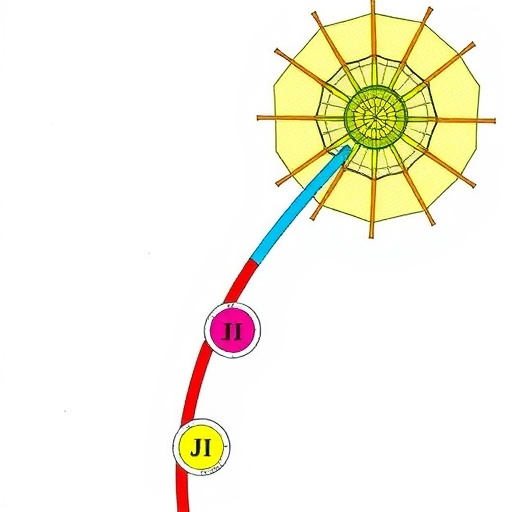In an exciting development in synthetic biology, a team of researchers led by D.H. Perez has unveiled groundbreaking synthetic agonists specifically designed for the targeted activation of Notch signaling pathways. This significant innovation holds potential implications for a multitude of diseases, particularly those driven by the aberrant regulation of cell signaling such as cancer and various developmental disorders. Notch signaling, an evolutionary conserved pathway, plays a critical role in cell communication, influencing cellular processes such as differentiation, proliferation, and apoptosis.
The study conducted by Perez and colleagues, published in Nature Chemical Biology, moves beyond traditional research methodologies by employing a novel approach that showcases the precision and control over Notch signaling activation. This advancement is particularly timely, given that the modulation of Notch signaling has been historically challenging, often yielding unexpected results. By engineering synthetic agonists, the team aims to overcome the limitations of natural ligands and develop more reliable mechanisms for targeted therapy.
Natural Notch ligands, such as Delta and Jagged, have served as the conventional means of signaling activation. However, these ligands often present challenges in specificity and efficacy, which can lead to unintended outcomes in therapeutic applications. The synthetic agonists created by the research team offer a fresh perspective, enabling a more predictable response in Notch-mediated processes. Their innovative approach highlights how synthetic biology can enhance our arsenal of therapeutic tools, particularly in intricate signaling pathways.
In their research, the team meticulously designed these synthetic agonists by leveraging structure-based design principles. They utilized advanced computational modeling to predict how these agonists would interact with Notch receptors. This process allowed for the fine-tuning of their molecular structures to optimize binding affinity and specificity. As a result, the synthetic agonists exhibit a remarkable ability to selectively activate specific receptors within the Notch pathway, paving the way for tailored therapeutic interventions.
One of the key findings of the study is the ability of these agonists to modulate the downstream effects of Notch signaling, which can be crucial in diverse biological settings. For instance, their work suggests that targeted Notch activation could stimulate stem cell differentiation or inhibit tumorigenesis under carefully controlled conditions. By providing a means of selectively influencing cellular behaviors, these synthetic molecules represent a paradigm shift in our understanding and utilization of Notch signaling.
The implications of this research extend beyond fundamental science into the realm of clinical applications. Given the versatility of Notch signaling in various tissues, the synthetic agonists might be deployed across a wide array of therapeutic contexts. For example, they could play a role in regenerative medicine, where harnessing stem cell capabilities is essential for tissue repair and regeneration. Similarly, their application in oncology could open doors for innovative cancer treatments that use precise modulation of Notch pathways to thwart tumor growth.
Furthermore, the development of these synthetic agonists exemplifies a significant step forward in the pharmaceutical industry. By providing a more tangible and controllable means of targeting Notch signaling, drug developers can work toward generating more reliable therapies with fewer side effects. The researchers foresee that this technology could substantially accelerate the process of drug discovery, reducing the time and resources typically required to identify viable candidates.
To ascertain the efficacy and safety of these synthetic agonists, the research team has initiated preliminary in vivo studies. Early results are promising, indicating that these molecules do not exhibit toxic effects at therapeutic doses and retain their efficacy in living organisms. The transition from bench to bedside remains a critical challenge, yet the data thus far provides optimism regarding the robustness of these synthetic compounds in potential therapeutic settings.
Additionally, the research could implicate the need for regulatory frameworks tailored to accommodate the rise of synthetic biology applications in medicine. As these technologies advance, ensuring ethical deployment while safeguarding public health will be paramount. The authors acknowledge the importance of developing guidelines for the use of synthetic molecules in clinical practice, emphasizing transparency and rigorous assessment of their implications.
The strategic caliber of this research exemplifies the fusion of computational biology and experimental techniques. By harnessing interdisciplinary methods, the team has not only advanced scientific understanding of Notch signaling but has also laid the groundwork for future innovations in the field. Ongoing research may lead to additional synthetic compounds that can target other components of the Notch signaling pathway, further broadening therapeutic horizons.
The scientific community eagerly anticipates further announcements from Perez and his collaborators as they continue to explore the realms of synthetic biology and cellular signaling. Their pioneering work is a testament to the power of ingenuity and collaboration in addressing complex biological challenges. With their eyes set on the future, they remain committed to pushing the boundaries of what’s possible in drug design and development.
As the excitement builds around these findings, stakeholders from academia to industry are beginning to take notice. The potential for partnership and investment in further research amplifies the promise of synthetic agonists as a game-changing approach in the fight against diseases linked to Notch signaling malfunctions. The hope is that as these innovations unfold, they can bring us closer to the realization of targeted therapies that can drastically improve patient outcomes.
In conclusion, the engineering of synthetic agonists for Notch signaling marks a significant milestone in the field of synthetic biology. With their precision, targeted functionality, and potential for widespread therapeutic applications, these compounds could usher in a new era of treatment strategies that harness the intricate and vital workings of cellular communication pathways. As the research progresses, it will undoubtedly ignite interest across disciplines, fostering new collaborations and advancements that might shape the future of medicine.
Subject of Research: Synthetic agonists for targeted activation of Notch signaling
Article Title: Engineering synthetic agonists for targeted activation of Notch signaling
Article References:
Perez, D.H., Antfolk, D., Chang, S. et al. Engineering synthetic agonists for targeted activation of Notch signaling.
Nat Chem Biol (2025). https://doi.org/10.1038/s41589-025-02030-y
Image Credits: AI Generated
DOI: https://doi.org/10.1038/s41589-025-02030-y
Keywords: Notch signaling, synthetic biology, synthetic agonists, targeted therapy, drug design




